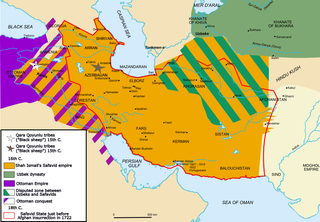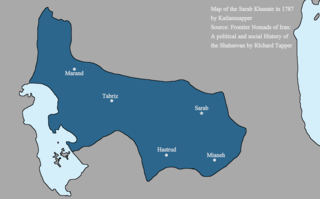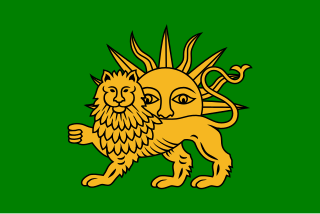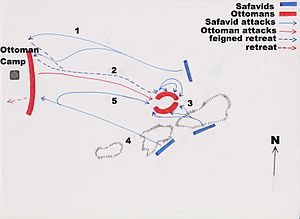
Abbas I, commonly known as Abbas the Great, was the fifth Safavid shah of Iran from 1588 to 1629. The third son of Shah Mohammad Khodabanda, he is generally considered one of the most important rulers in Iranian history and the greatest ruler of the Safavid dynasty.
The Russo-Persian Wars or Russo-Iranian Wars were a series of conflicts between 1651 and 1828, concerning Persia and the Russian Empire. Russia and Persia fought these wars over disputed governance of territories and countries in the Caucasus. The main territories disputed were Aran, Georgia and Armenia, as well as much of Dagestan – generally referred to as Transcaucasia – and considered part of the Safavid Iran prior to the Russo-Persian Wars. Over the course of the five Russo-Persian Wars, the governance of these regions transferred between the two empires. Between the Second and Third Russo-Persian Wars, there was an interbellum period in which a number of treaties were drawn up between the Russian and the Persian Empires, as well as between both parties and the Ottoman Empire. Ottoman interest in these territories further complicated the wars, with both sides forming alliances with the Ottoman Empire at different points throughout the wars. Following the Treaty of Turkmenchay, which concluded the Fifth Russo-Persian War, Persia ceded much of its Transcaucasian territory to the Russian Empire.

The Persian campaign or invasion of Iran was a series of military conflicts between the Ottoman Empire, British Empire and Russian Empire in various areas of what was then neutral Qajar Iran, beginning in December 1914 and ending with the Armistice of Mudros on 30 October 1918, as part of the Middle Eastern Theatre of World War I. The fighting also involved local Persian units, who fought against the Entente and Ottoman forces in Iran. The conflict proved to be a devastating experience for Persia. Over 2 million Persian civilians died in the conflict, mostly due to the Armenian genocide by the Ottoman regime and Persian famine of 1917–1919, influenced by British and Russian actions. The Qajar government's inability to maintain the country's sovereignty during and immediately after the First World War led to a coup d'état in 1921 and Reza Shah's establishment of the Pahlavi dynasty.
Iran and Georgia have had relations for thousands of years. Eastern and Southern Georgia had been under intermittent Persian suzerainty for many centuries up to the early course of the 19th century, while western Georgia had been under its suzerainty for much shorter periods of time throughout history. Georgia especially rose to importance from the time of the Persian Safavids.

The Ottoman–Safavid War of 1623–1639 was a conflict fought between the Ottoman Empire and Safavid Iran, then the two major powers of Western Asia, over control of Mesopotamia. After initial Persian success in recapturing Baghdad and most of modern Iraq, having lost it for 90 years, the war became a stalemate as the Persians were unable to press further into the Ottoman Empire, and the Ottomans themselves were distracted by wars in Europe and weakened by internal turmoil. Eventually, the Ottomans were able to recover Baghdad, taking heavy losses in the final siege, and the signing of the Treaty of Zuhab ended the war in an Ottoman victory. Roughly speaking, the treaty restored the borders of 1555, with the Safavids keeping Daghestan, Shirvan, eastern Georgia, and Eastern Armenia, while western Georgia and Western Armenia decisively came under Ottoman rule. The eastern part of Samtskhe (Meskheti) was irrevocably lost to the Ottomans as well as Mesopotamia. Although parts of Mesopotamia were briefly retaken by the Iranians later on in history, notably during the reigns of Nader Shah (1736–1747) and Karim Khan Zand (1751–1779), it remained thenceforth in Ottoman hands until the aftermath of World War I.
The Ottoman–Safavid war of 1603–1612 consisted of two wars between Safavid Iran under Shah Abbas I and the Ottoman Empire under Mehmed III and his son Ahmed I. The first war began in 1603 and ended with a Safavid victory in 1612, when they regained and reestablished their suzerainty over the Caucasus and Western Iran, which had been lost at the Treaty of Constantinople in 1590.

The Ottoman–Persian War (1578–1590) or Ottoman–Iranian War of 1578–1590 was one of the many wars between the neighboring arch rivals of Safavid Empire and the Ottoman Empire.
Treaty of Nasuh Pasha was a treaty between the Ottoman Empire and Safavid Persia after the war of 1603–1612, signed on 20 November 1612. It was made after a decisive Safavid victory. The main terms in the treaty included granting back Persian suzerainty over all of the Caucasus.
Treaty of Serav was a treaty between Ottoman Empire and Safavid Persia after the war of 1615–1618.
The Treaty of Ahmet Pasha was a treaty signed on 10 January 1732 between the Ottoman Empire and Safavid Persia.

The Sarab Khanate was a khanate centered around Sarab from 1747 and ruled by the Kurdish Shaqaqi tribe.

The campaigns of Nader Shah, or the Naderian Wars, were a series of conflicts fought in the early to mid-eighteenth century throughout Central Eurasia primarily by the Iranian conqueror Nader Shah. His campaigns originated from the overthrow of the Iranian Safavid dynasty by the Hotaki Afghans. In the ensuing collapse and fragmentation of the empire after the capture of the Iranian capital of Isfahan by the Afghans, a claimant to the Safavid throne, Tahmasp II, accepted Nader into his service. After having subdued north-west Iran as well as neutralising the Abdali Afghans to the east and turning Tahmasp II into a vassal, Nader marched against the Hotaki Afghans in occupation of the rest of the country. In a series of incredible victories the Afghans were decimated and Tahmasp II returned to the throne as a restored Safavid monarch.

The Guarded Domains of Iran, commonly called Safavid Iran, Safavid Persia or the Safavid Empire, was one of the largest and longest-lasting Iranian empires. It was ruled from 1501 to 1736 by the Safavid dynasty. It is often considered the beginning of modern Iranian history, as well as one of the gunpowder empires. The Safavid Shāh Ismā'īl I established the Twelver denomination of Shīʿa Islam as the official religion of the empire, marking one of the most important turning points in the history of Islam.

The siege of Tabriz was a military conflict during the Ottoman–Safavid war of 1603–1612. As a result of a successful siege, Tabriz was returned to the Safavids after 18 years of Ottoman rule.

The Battle of Yeghevārd, also known as the Battle of Baghavard or Morad Tapeh, was the final major engagement of the Perso-Ottoman War of 1730–1735 where the principal Ottoman army in the Caucasus theatre under Koprulu Pasha's command was utterly destroyed by only the advance guard of Nader's army before the main Persian army could enter into the fray. The complete rout of Koprulu Pasha's forces led to a number of besieged Ottoman strongholds in the theatre surrendering as any hope of relief proved ephemeral in light of the crushing defeat at Yeghevārd. One of Nader's most impressive battlefield victories, in which he decimated a force four or five times the size of his own, it helped establish his reputation as a military genius and stands alongside many of his other great triumphs such as at Karnal, Mihmandoost or Kirkuk.

Nader's Western Persia campaign of 1730 was his first against perhaps his most formidable of adversaries, namely the Ottomans, where he proved triumphant in conquest. The great successes of his expedition, however, were rendered null when Shah Tahmasp II decided to take personal command of the theatre in Nader's absence, forcing a furious Nader to return and rectify the situation after forcing Tahmasp's abdication in favour of his infant son Abbas III.

The campaign of 1731 was a failed attempt by Tahmasp II of the Safavid dynasty to launch an offensive into Ottoman held Caucasus which ended in a disastrous defeat with all of Nader's gains during the previous year being lost. The result of this particular military catastrophe was still overturned with Nader's return from the east but would have much more significant impact on the Safavid dynasty itself as Tahmasp II sealed his own fate by initiating this ill fated expedition.
The Khoy Khanate, also known as the Principality of Donboli, was a hereditary Kurdish khanate around Khoy and Salmas in Iran ruled by the Donboli tribe from 1210 until 1799. The khanate has been described as the most powerful khanate in the region during the second half of the 18th century. The official religion of this principality was originally Yezidism, until some rulers eventually converted to Islam. The principality has its origins under the Ayyubid dynasty and was ultimately dissolved in 1799 by Abbas Mirza. During this period, the status of principality oscillated between autonomous and independent.
The Battle of Sufiyan took place on 6 November 1605, during the Ottoman–Safavid War of 1603–1618. The Safavids, under King (Shah) Abbas I, beat a numerically superior, fully-fledged Ottoman army. It was one of King Abbas I's greatest military victories. According to Colin Imber: "For the Ottomans the battle of Sufiyan was a greater disaster than anything they had experienced in Hungary, where the war which had begun in 1593 had revealed Ottoman military deficiencies in the face of new European weapons and tactics."











